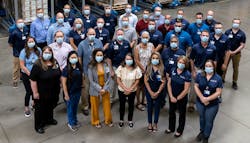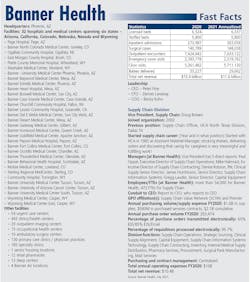If the Supply Chain Services team at Banner Health ever decided to bottle up, package and market a secret strategic and tactical formula for their clinical, financial and operational success – which they don’t intend to do and won’t because they don’t believe in one anyway – the mindset would encapsulate a simple tenet.
Nothing earth-shattering or astoundingly profound: They never let process or product get in the way of patients and people.
Believe it or not, Banner Health’s Supply Chain strategic plan can trace its roots back some two decades earlier, according to Doug Bowen, Vice President, Supply Chain Services. In fact, Bowen attributes the success of his award-winning team to “consistent, dedicated and purposeful work,” the hallmarks of leadership and service to achieve a “highly effective supply chain.” [Editor’s Note: Learn more online, “Banner Health’s Supply Chain Services team shares mindsets, milestones that motivate success within their enterprise.”]
Bowen’s team views much of what typically can be classified as “supply chain responsibilities,” such as evaluating, contracting, purchasing, storing, moving, maintaining and replenishing equipment and supplies, as tactical outgrowths of a quartet of key strategies.
Perfecting the customer experience represents one of the four strategies, exemplified in part by a “digital front door” that enables customers – and patients – to use computers, smart phones and apps to access medical records, schedule appointments, check in for procedures, consult with clinicians and pay bills, among other functions. Although Information Technology may be responsible for such technology, Supply Chain engineered its own carve-out on which to focus.
Enter Sofia, the quintessential customer on whom Supply Chain concentrates all its activities and bases its overarching motivation and philosophy.
“Sofia is our customer, and we work to serve her and her extended family,” Bowen said. “Supply chain is not just a department. It is a practice that extends beyond the designated supply chain department walls to serve Sofia and her family, whenever and wherever she needs healthcare. Banner Health’s Supply Chain Services team champions supply chain practices and initiatives to better serve Sofia. Our focus is on quality, outcomes and cost.” Bowen punctuates the distinct order of issues in his last sentence by emphasizing essential high-quality, cost-effective supplies.
Bowen assures that Sofia is real, representative of the people that Banner Health serves, and not some archetypal or digital avatar/concept used to impact staff behavior and performance.
“Sofia is short of time and money, and coordinates care for herself and her extended family,” he described. “Sofia asks the question, ‘what can Banner Health do to make my life easier?’ If we design care to make things easier for Sofia, we can make life better for the thousands of people who interact with us each day.
“Sofia is real and she is often invited to appear at our leadership meetings to remind us that everything we do revolves around a customer, and we must continually strive to design and provide care that meets and exceeds Sofia’s expectations,” he added.
“Banner Supply Chain indirectly perfects the customer experience by collaborating with our clinical team to ensure they have what they need to successfully care for Sofia and her family,” Bowen continued. “We work to protect our team so that instead of worrying about supplies or worrying about being protected in caring for patients, they may focus on the care they need to provide our patients.”
Helping customers be their healthiest represents another of the four strategies.
“We are change champions that collaborate, communicate and innovate to optimize network value for our patients, payers, providers and suppliers, using a fully integrated supply chain model,” Bowen indicated. “Just like healthy living must be a continuous practice, supply chain must be a continuous practice. At Banner Health, supply chain is a way of operating. Selecting high-quality, cost-effective supplies, services and technology ensures our customers’ experience the very best patient care.”
Supply Chain Services embraces a “triple aim” as the vision driving the team, according to Bowen. The triple aim encompasses reducing the cost of care, improving the experience of care and improving population health. “Improving the experience of care is designed to have a positive impact on both the caregiver and the patient,” he noted. “Providing products and services that make the caregiver’s job easier is a force multiplier that enables a positive patient experience.”
Engaging and inspiring its people and growing its reach and impact are the remaining two strategies, fueled by top-down communications from senior leadership as to objectives, progress and successes, according to Bowen. Supply Chain Services also recognizes and understands where it fits within the machinations of Banner Health’s operational core.
“While we excel in supply chain practices, we know we need to collaborate and engage with frontline team members because they are the experts in their area,” Bowen noted. “Working collaboratively creates additional support for our philosophy where supply chain is everyone’s business. We openly encourage idea sharing to reduce supply expense and identify supplies with the best cost, quality and outcomes.
“We engage and inspire our team through frequent and repetitive communication that includes opportunity for dialogue, and by focusing on doing what is important to achieve our mission,” he continued. “While workstreams are numerous and goals change over time, our focus on our higher strategy is what binds and engages our team to be ‘one supply chain’.”
Formed in 1999 from the merger of Samaritan Health System and Lutheran Health Systems, Banner Health spent the next two decades expanding and growing exponentially, Supply Chain Services being no exception. What’s noteworthy is that Banner Health generated $1.5 billion in revenue during its first year in operation and grew that more than sevenfold to $11 billion last year. To put this growth in perspective, Banner Health now spends more on just supplies ($1.6 billion) than its entire first year’s revenue stream ($1.5 billion).
Since 1999, Supply Chain Services expanded its warehouse space to create a mammoth Consolidated Service Center (CSC) that also incorporates Accounts Payable, Biomedical Engineering and Pharmacy Services, among others. They added pharmacy robotics and mail-order prescription services, pharmacy distribution and compounding services, surgical kit packing manufacturing and sterilization operations, high-density pallet storage with automated shuttling and its own internal group purchasing organization (named Supply Chain Value Network) to support its growing number of facilities that are augmented by its membership in Premier.
While they used their clinically integrated model to support a patient-driven value network so that caregivers could concentrate on saving lives, according to Bowen, they remain “data-driven, disciplined in cost controls and results-oriented.” Despite inflation and increasing industry cost trends, Supply Chain has produced year-over-year cost improvements, he added.
Last year, the Supply Chain Services team faced perhaps its most intense crisis yet with the onset of the COVID-19 pandemic – and it bobbed and weaved, but never buckled to justify its reputation within the C-suite as a “highly effective supply chain” that senior management moved quickly to leverage for financial health and liquidity and to establish crisis-command and operations bases for the community. In May 2020, the organization joined with Premier and 14 other Premier members to acquire a 20% investment stake in Prestige Ameritech to ensure availability of exceedingly high-demand N95 masks.
For these reasons, Banner Health has earned Healthcare Purchasing News’ “2021 Supply Chain Department of the Year” honors.
[Editor’s Note: Read more online, “Banner Health leaders spotlight Supply Chain service expansion, fortification” and “Pandemic fuels pivot to sustainable process innovations for Banner Health.”]
Crisis with confidence
While a crisis can make or break an individual or organization, in Banner Health’s case – Supply Chain Services specifically – the pandemic crisis served to define them and reinforce their reputation as a highly effective operation.
“A highly effective supply chain is one that consistently produces the desired results for the patient and the enterprise,” Bowen characterized. “A highly effective supply chain can quickly respond to critical needs and do it in a way the meets Sofia’s needs while improving outcomes and reducing costs. A highly effective supply chain can also handle multiple complex challenges at the same time.”
Banner Health’s C-suite witnessed Supply Chain Services’ transition and transformation from the start through two decades of progress, according to Paul Oppat, Executive Director, Supply Chain Services.
“Banner’s Supply Chain continuously improves, innovates and demonstrates annual results,” Oppat noted. “As 2020 hit, senior leaders were confident in the immediate response and reliable performance from our Supply Chain. We immediately took actions to leverage our existing strengths.
“With the growing threat of a pandemic, Supply Chain Services was part of the early and ongoing execution of our pandemic preparedness and response plan,” he continued. “Our senior leaders understood the value of the supply chain and how our pandemic response would require extraordinary supply chain performance. Some of this was self-evident to all, but our preexisting and strong partnership with senior leaders made the response to the pandemic more effective.”
Bowen recaps his team’s progress during the last two decades as more evolutionary and organic.
“We are continuously looking to improve our operations,” he said. “We started with what we knew and with each new development it was an opportunity to learn and grow and increase our ability to better serve our team members and patients. Our growth and ability to generate revenue ensures we are not just an overhead cost of doing business, but instead a resource to leverage. We discovered that our CSC was not just a location for doing business. It was actually a new business model for the supply chain.”
While Banner Health’s Supply Chain Services team embraces clinical integration, Bowen acknowledges that the definition of the term can be easily customizable. But he knows what works for Banner Health clinicians and Supply Chain Services.
“A clinically integrated supply chain incorporates the contributions of all that it impacts – clinicians, physicians, vendors, end users, support operations, administration, tech management, etc.,” he explained. “Integration is key to the definition. Banner clinicians are integrated into every facet of the decision-making process. From the initial request, review of product(s), approval and finally the outcome follow-up using a make-good analysis. It is common for many healthcare systems to neglect to complete the make-good analysis over time and thus continue using products and practices that are no longer clinically integrated and less than optimal.”
Clinically integrated leadership
As much of the nation started recognizing COVID-19 as a pandemic in mid-to-late March 2020, implementing protective measures, such as quarantining and regulating availability of “non-essential services;” managing personal protective equipment (PPE) and sanitizing product access and consumption; and navigating policy waves, Banner Health already was two full months into its operational response. Think less acceleration and more cruise control.
Bowen credits Banner Health’s Chief Medical Officer with the foresight. The organization activated a multi-disciplinary group, dubbed the “PPE Cabinet” in late January 2020 in anticipation of supply chain disruption and also to improve preparedness for future surges that may be unrelated to COVID-19.
“Dr. Marjie Bessell is very proactive, and her Magic 8 ball was right on target,” Bowen asserted. “She was reading the early reports on the outbreak and immediately took action. She assembled the newly formed PPE Cabinet right away to begin scenario planning and discussions. At that point in time, in late January, we just called it ‘the virus’ as COVID-19 received its name on Feb. 11, 2020.”
Bowen’s team set five goals for itself:
1. Understand inventory availability and days-on-hand prior to and during hospital volume surges.
2. Act as a rapid approval source for alternative supplies and sources.
3. Clarify and expedite expected product delivery from direct sources and distributors.
4. Reallocate (rebalance) inventories between facilities to match patient volume and criticality.
5. Assure the full capabilities of Banner Health’s Consolidated Service Center are enabled.
If anything, the pandemic drew clinical and business stakeholders closer together as they related to emergency preparedness, helped them balance risk analysis related to clinical preparedness and financial performance and gave them a better understanding of non-acute needs during a crisis, according to Bowen.
“The pandemic experience has provided us with two valuable lessons learned,” he said. “Know what you are capable of and also know what your limitations are.”
Tower that empowers
Taking a cue from air traffic controllers that require visibility of flight patterns, Banner Health instituted a “Supply Chain Control Tower” model to increase visibility over operations to pivot when necessary, according to James Hutchinson, Senior Director, Supply Chain Services.
“Faced with several natural disasters over the last several years [that] had a direct impact on our supply chain, we began developing the control tower concept,” Hutchinson said. “It has been a way for us to visualize potential failure points within the supply chain from manufacturer of supply to final patient consumption while developing mitigation strategies to overcome each while remaining focused on the end-to-end fulfillment cycle.”
Because the pandemic further demonstrated the need for greater visibility and modeling of supply data, Supply Chain Services embarked on a multi-year initiative to institute “highly interdependent digital capabilities through 360-degree oversight across the supply chain continuum.” This will enable them to minimize – if not eliminate – operational risk as local and globalized markets, and logistics are compromised, according to Hutchinson.
As customer demand becomes more volatile, and supplier and inventory status are disrupted, service providers must pursue a more dynamic and holistic response involving “supply management, smart automation, and advanced analytics utilizing a combination of digital technologies to bring visibility to and continuously improve upon value capture throughout the source-to-settle lifecycle,” he added.
Hutchinson reveals they plan to implement a managed supply formulary, virtual procurement interface and digitally guided buying. “The intent is to use technology and data efficiently and reliably to allow for easier strategic pivots in an unpredictable time and environment,” he added.
Might this represent the future and next wave of supply chain development? Maybe, Hutchinson says.
“Tech is moving fast, and our business model needs to stay current to keep up,” he said. “Advances in digital technology, artificial intelligence and robotic process automation have and will continue to change the way that supply chain does business and interacts with customers. On-premise supply chain technologies of the past are making way for federated cloud-based digital technologies that can scale and move at the speed of business giving decision makers real time information to improve the business and magnify the impact of the supply chain.”
Strategic blinking
Discussions with Bowen reinforce that he’s a doer striving to get things done. The idea of spending less time creating strategy and more time executing the strategy represents an important teaching and learning element for him.
“When you do strategic analysis, you identify where you want to go or what you want to be,” he told HPN. “At that time, you need to decide how you are going to get there and what you will need to get there. Once those resources are identified, you need to put a plan together that gets you on the road to achieving your objectives. At Banner, our CEO, Peter Fine, continually reminds us to ‘plan the work, and then work the plan.’ The secret is in ‘working the plan.’ In reality, working the plan is sometimes so difficult, so time consuming and so tedious that some leaders – and teams – are tempted to go back to the drawing board to create a new plan that might be easier work. When this bad cycle is repeated, you will find analysis paralysis.”
To continually move forward, Bowen reminds himself of an old saw, “Stick to your task ’til it sticks to you; beginners are many, but enders are few.”
There's more to the story. Read on:
Banner Health’s Supply Chain Services team shares mindsets, milestones that motivate success within their enterprise
Banner Health leaders spotlight Supply Chain service expansion, fortification
Pandemic fuels pivot to sustainable process innovations for Banner Health
2021 Honorable Mention
Banner Health Supply Chain team salutes supplier partners
Who supports an award-winning healthcare supply chain organization? Banner Health’s Supply Chain team appreciates the product and service companies that have helped them develop and improve their operations and performance. The team shines a spotlight on 19 below that have motivated and fortified them to make a difference and succeed.
Above and Beyond came on board to help Banner with movement of critical equipment between our facilities at all hours of the day.
Ace Express assisted with countless urgent requests to transport critical supplies from our distribution center to many facilities across the state of Arizona.
Agiliti aided us in locating various pieces of rental equipment, such as beds, ventilators and infusion pumps.
American Contract Systems (ACS) supplied custom sterile kitting and sterilization packs that were critical to continue to meet our surgical needs, especially as surgical procedures opened back up and demand increased.
Arjo assisted in bringing in rental beds from various parts of the country so that we could make sure we had the quantity of beds needed to meet our surge capacity.
AZ Fashion Source pivoted quickly to manufacturing reusable isolation gowns.
Big AZ Tents supplied tents for the vaccination sites and triage centers. Many of our hospital Emergency Departments were so swamped that we set up triage tents to better handle the high volume. See http://bannerhealth.mediaroom.com/triagetents.
Cardinal Health’s Optifreight coordinated and expedited the shipment of critical equipment as well as supplies.
Crothall worked 24/7 – including Christmas Day and New Year’s Day – to provide clean reusable isolation gowns and patient linens.
Dirck’s supplied overflow storage of critical PPE products to help assure Banner had the appropriate amount of supply to keep our staff safe.
Falcon Corp. pivoted quickly to manufacturing reusable isolation gowns.
Freedom Medical helped with locating various pieces of rental equipment, such as beds, ventilators and infusion pumps.
Halyard Health (part of the Owens & Minor family) came up with creative solutions for PPE supplies, such as masks and gloves, and ramped up products for surgical packs.
Hillrom listened to customer feedback and adapted to new challenges.
Intuitive Surgical created AMP, an innovative way to obtain and pay for robotic technology.
Med One supported Banner’s early needs for renting respiratory equipment and IV pumps when our local rental companies were not able to support our usage.
Premier S2S offered nimble and expedited direct sourcing support that allowed Banner to quickly find PPE and other supplies that were just not available from conventional sources.
Prestige Ameritech became a domestic source for supplying procedure masks and N95 masks, both which were in short supply considering exponential increases in demand.
Standard Textile worked with Banner to locate prewashed linen to meet surge in linen utilization.

Rick Dana Barlow | Senior Editor
Rick Dana Barlow is Senior Editor for Healthcare Purchasing News, an Endeavor Business Media publication. He can be reached at [email protected].













